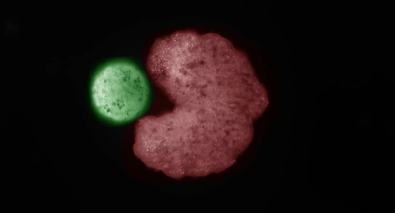Meet the Xenobots: Self-Replicating, Living Robots

A semitoroidal xenobot (red) collecting a sphere of stem cells (green). Credit: Douglas Blackiston & Sam Kriegman
December 6, 2021
It seems easy to distinguish between a living animal and a robot. One is flesh, the other metal. One has blood coursing through its veins, and the other has electricity. But when one takes living cells, imbues them with life through programming, and gives them the ability to move and reproduce on their own – what has been created?
Frankenstein’s monster may come to mind for many people, but scientists have done exactly that in real life, and they have dubbed their creations “xenobots”. Almost two years ago, they were shown to be programmable for simple tasks, but now they have exhibited the ability to reproduce in a way that no other organism can.
Xenobots are small, living robots made of cells from Xenopus laevis, the African clawed frog. This species was used in particular because they are biologically understood very well compared to other amphibians, they can live for up to 30 years in captivity, and because they lay eggs year-round. The scientists behind the xenobots incubated stem cells from the embryos of the frogs and used a supercomputer to create a plan for the structure of the new organism. Then, they used extremely precise tools to bring the supercomputer’s idea to reality on the scale of a millimeter.
The resultant living robots were programmable, and they could complete tasks like moving small objects and self-healing. They moved around by taking advantage of the rhythmic motion of heart cells, but this was a limited method of locomotion. Nevertheless, they showed the ability to form swarms and clean up particles in their Petri dishes.
Then, in March of 2021, the team announced that they had created Xenobots 2.0. These new robots were equipped with cilia, small hairs which can be used to help the xenobots move themselves much faster. They could complete the task of cleaning up particles of iron oxide faster, and travel through small tubes. In addition, they injected the xenobots with a special protein called EosFP, which made them turn red if they were exposed to a certain wavelength of light. In effect, this means that the xenobots can store a small “memory” – namely, the memory of having been exposed to that wavelength of light. As for their healing abilities, they were reported to be able to close a laceration stretching across their entire body in under five minutes.
And even that was many months ago! On November 29, 2021, the team published their paper on Xenobots 3.0, the latest and most advanced of the versions. The main feature of these new xenobots is their ability to reproduce kinematically. Kinematic self-replication is the ability for the xenobots to take material from their environment and physically construct new xenobots. No other organism uses this method of reproduction; rather, it occurs at the molecular level, when complex molecular machines create other molecules. The researchers spread X. laevis stem cells around the “arena”, and the xenobots collected the stem cells before piling them up. The cells would compact into new replicas of the xenobots.
However, this mechanism only works to a certain degree, in that each generation produced fewer and fewer functional xenobots. The spheroidal xenobots produced an average of 1.2 generations and a maximum of two before self-replication became impossible. To improve the results, the researchers used an evolutionary algorithm, which found that the optimal shape for xenobots was a “semitoroid”. (For reference, some have compared the shape to the character Pac-Man when viewed from above.) When this was tested in real life, the semitoroidal xenobots lasted for an average of three generations and a maximum of four.
These xenobots are the first self-replicating living robots. It is also important to note that the cells used are genetically unchanged; they were simply “liberated”, as the paper puts it, from their original environment, and they started to form new behaviors in their new environment.
The xenobots have lots of potential uses; for example, they could be used to clean up environmental contaminants, deliver drugs, manufacture products on very small scales, and act as living sensors in various environments. The NATO Science and Technology Organization, a subsidiary of NATO, stated in their 2020-2040 Tech Trends Report that “[d]evelopments in [biological engineering] include AI optimised xenobots (i.e specialised bio-robots) for nano-scale manufacturing and living bio-sensors (e.g. persistent living aquatic or terrestrial sensors, or CBRN monitoring [detection of chemical, biological, radiological, or nuclear threats]).”
Xenobots seem exotic and exciting, and – unlike Dr. Frankenstein’s creation – they have the potential to open up many new opportunities for humanity.
Works Cited
-
Kriegman, Sam, et al. “Kinematic self-replication in reconfigurable organisms.” Edited by Terrence J. Sejnowski. Proceedings of the National Academy of Sciences of the United States of America, vol. 118, no. 49, 2021. PNAS, https://www.pnas.org/content/118/49/e2112672118/tab-figures-data. Accessed 3 December 2021.
-
Aridi, Rasha. “Scientists Unveiled the World’s First Living Robots Last Year. Now, They Can Reproduce.” Smithsonian Magazine, 2 December 2021, https://www.smithsonianmag.com/smart-news/scientists-unveiled-the-worlds-first-living-robots-last-year-now-they-can-now-reproduce-180979150/. Accessed 5 December 2021.
-
Brown, Joshua. “Team Builds First Living Robots That Can Reproduce.” The University of Vermont, 29 November 2021, https://www.uvm.edu/news/story/team-builds-first-living-robots-can-reproduce. Accessed 5 December 2021.
-
Mendoza, Jordan. “Living robots can now reproduce using artificial intelligence.” USA Today, 30 November 2021, https://www.usatoday.com/story/news/nation/2021/11/30/living-robots-reproduce-artificial-intelligence/8801610002/. Accessed 5 December 2021.
-
Neuman, Scott. “Living robots known as xenobots can self-replicate.” NPR, 1 December 2021, https://www.npr.org/2021/12/01/1060027395/robots-xenobots-living-self-replicating-copy. Accessed 5 December 2021.








